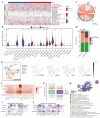A mitochondrial-related gene signature predicts prognosis and immunotherapy response in hepatocellular carcinoma
- PMID: 40659697
- PMCID: PMC12260083
- DOI: 10.1038/s41598-025-09464-3
A mitochondrial-related gene signature predicts prognosis and immunotherapy response in hepatocellular carcinoma
Abstract
Hepatocellular carcinoma (HCC) remains a leading cause of cancer-related mortality worldwide, characterized by frequent recurrence and poor clinical outcomes. This study aimed to develop a mitochondria-related genes (MRGs) signature for prognostic stratification and immunotherapy response prediction in HCC patients. Derived from the TCGA-LIHC cohort and validated across independent ICGC-JP and GEO datasets, the MRGs signature comprised four genes (DTYMK, ABCB6, GOT2, and TOMM40L) that were markedly overexpressed in HCC tissues and strongly associated with adverse prognosis. MRGs-based nomogram exhibited superior predictive accuracy, highlighting their clinical potential for personalized risk assessment. Within the tumor microenvironment, high-MRGs tumors demonstrated significant enrichment of immunosuppressive components, including regulatory T cells, tumor-associated macrophages, and checkpoint molecules PD-1 and CTLA-4. The MRGs-high subgroup showed heightened sensitivity to cisplatin but resistance to erlotinib, and impaired immunotherapy responses, which has potential clinical transformation value in the design of individualized combination therapy. Functional validation revealed ABCB6 as a key oncogenic driver, with genetic depletion significantly attenuating HCC cell proliferation, migration, and invasion in vitro. Collectively, the MRGs signature serves as a better predictor of HCC prognosis and therapeutic resistance, while its core component ABCB6 emerges as a critical regulator of HCC malignancy.
Keywords: ABCB6 transporter; Hepatocellular carcinoma; Immunotherapy resistance; Mitochondrial metabolism; Prognostic biomarker.
© 2025. The Author(s).
Conflict of interest statement
Declarations. Competing interests: The authors declare no competing interests.
Figures








References
-
- Sung, H. et al. Global cancer statistics 2020: GLOBOCAN Estimates of Incidence and Mortality Worldwide for 36 Cancers in 185 Countries. CA Cancer J. Clin.71, 209–249. 10.3322/caac.21660 (2021). - PubMed
-
- El-Serag, H. B. Hepatocellular carcinoma: Recent trends in the United States. Gastroenterology127, S27–S34. 10.1053/j.gastro.2004.09.013 (2004). - PubMed
-
- Venook, A. P., Papandreou, C., Furuse, J. & de Guevara, L. L. The incidence and epidemiology of hepatocellular carcinoma: A global and regional perspective. Oncologist15(Suppl 4), 5–13. 10.1634/theoncologist.2010-S4-05 (2010). - PubMed
-
- Lu, J. et al. Management of patients with hepatocellular carcinoma and portal vein tumour thrombosis: comparing east and west. Lancet Gastroenterol. Hepatol.4, 721–730. 10.1016/S2468-1253(19)30178-5 (2019). - PubMed
MeSH terms
Substances
LinkOut - more resources
Full Text Sources
Medical
Miscellaneous

